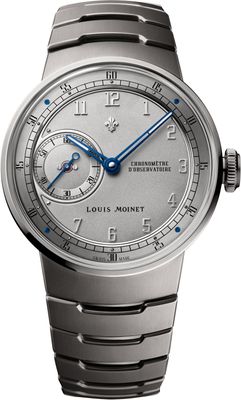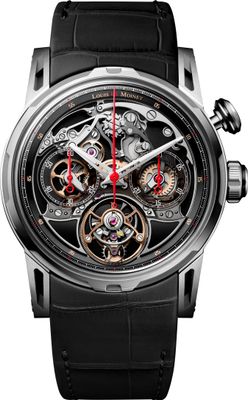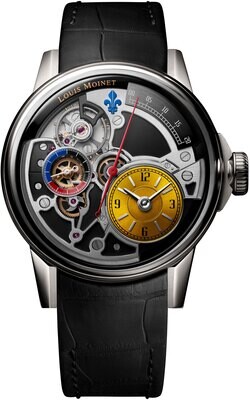The BLACK MOON, which comes in a limited edition of 60 pieces, features a novel display of the lunar cycle. The full moon and the new moon are represented by two lunar meteorites placed on a domed central disc: a first in watchmaking! An index at 3 o'clock, framed in red, points to the current phase. The timepiece announces the full moon when the fragment circled in red is aligned with the indicator.
The sober look of this timepiece belies the mechanism driving this astronomical moon complication, which is the product of cutting-edge engineering and technology. This complex device, made up of a gear train including a 135-tooth wheel, provides excellent precision. Unlike conventional moon phase displays, the BLACK MOON’s is especially precise, with a deviation of just one day in 122 years.
Luc Labenne, a famous meteorite hunter and friend of Jean-Marie Schaller, still remembers the day in 2001 before he discovered his first lunar meteorite. He had just landed in Muscat, Oman. That evening, the full moon shone with a particularly mysterious light. It seemed like a celestial omen leading him to his amazing find the next day!
GADAMIS 005
Gadamis 005, considered by experts to be the most beautiful lunar meteorite of all, comes from a region explored by the crew of the Apollo 16 mission. It has an extraordinary structure and a mottled grey-white texture that suggests the enigmatic beauty of the moon when it reaches its most luminous phase.
DHOFAR 457
Dhofar 457 owes its intense black hue to its origin: a lunar crater. Following an initial impact on the Moon, a subsequent event dislodged a portion of the crater and propelled it into space, where it journeyed until it reached Earth, landing in the Dhofar desert, hence the name: Dhofar 457.
On the BLACK MOON, the Dhofar 457 lunar meteorite indicates the full moon. The fragment is ringed in red and shines elegantly against the black, sanded background of the domed lunar disc. It’s a powerful tribute to the dazzling full moon night that preceded its extraordinary discovery.
Aventurine draws the eye with its twinkling particles on a dark blue backdrop that recalls the enchanting spectacle of a starry sky. This material originated on Murano Island, Italy, at the beginning of the seventeenth century and was created quite by accident. A glass blower had dropped some copper filings in molten glass that was slowly cooling. This gave rise to the name, aventurine, which is derived from the Italian term all’avventura, meaning “by chance”.
The dial surrounding the central lunar disc was conceived three-dimensionally and offers stunning interplay among the different planes. It rests on an aventurine base that evokes the immensity of the starry night skies. Hovering over it is a very modern structure that is in fact a fascinatingly complex element. The indexes are held in place by a central ring and a flange and seem to float mysteriously above the celestial background. Optimal visibility in the dark is ensured by a generous application of luminescent mass in the centre of each index. The index at 3 o'clock, framed in red, indicates the moon's position. The sobriety of the flange also contributes to the neat, modern look.
The BLACK MOON is assembled in a 18K red gold case, polished and satin-finished, with sleek, modern lines. The domed sapphire crystal is a high-tech feat in itself that enables one to appreciate the depth and detail of the dial. The openworked lugs perfectly underline the integration of the strap. The crown is adorned with the emblem of Les Ateliers Louis Moinet, a beautiful Fleur de lys.
















